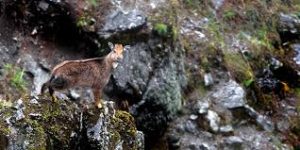Today’s Current Affairs:30th September 2025 for UPSC IAS exams, State PSC exams, SSC CGL, State SSC, RRB, Railways, Banking Exam & IBPS, etc
Table of Contents
Armed Forces (Special Powers) Act (AFSPA), 1958:

The Assam government recently extended the Armed Forces (Special Powers) Act (AFSPA), 1958, in three districts for another six months.
- It is a law enacted by the Parliament in 1958 which gives the armed forces special powers and immunity to maintain public order in “disturbed areas”.
- It can be applied only after an area has been declared “disturbed” under section 2 of the Act.
Declaration of Disturbed Areas: - Defined under Section 3 of the Act, a “disturbed area” is where the use of armed forces is deemed necessary to support civil authorities in maintaining law and order.
- An area can be declared disturbed due to conflicts or disputes between various religious, racial, linguistic, regional, or caste-based communities.
- The central government, Governor of the state, or the administrator of the Union Territory can declare the whole or part of a state or union territory as a disturbed area.
- Once declared, the region is maintained as disturbed for at least three months under The Disturbed Areas (Special Courts) Act, 1976.
- The scope and duration of AFSPA can vary depending on the region’s security situation.
- The ‘special powers’ of armed forces under AFSPA are:
- They have the authority to prohibit a gathering of five or more persons in an area, can use force even to cause death or even open fire after giving due warning, if they feel a person is in contravention of the law.
- If reasonable suspicion exists, the army can also arrest a person without a warrant, enter or search a premises without a warrant, and ban the possession of firearms.
- Any person arrested or taken into custody may be handed over to the officer in charge of the nearest police station along with a report detailing the circumstances that led to the arrest.
- These armed forces are immune from prosecution unless the Union Government provides sanction to the prosecuting agencies.
- Where is AFSPA in force now? Currently, AFSPA is active in Assam, Manipur, Nagaland, Arunachal Pradesh, and the UT of J&K.
Jal Prahar 2025:

The Indian Navy recently concluded the ‘Jal Prahar 2025’ joint exercise with the Indian Army to enhance amphibious operations along the eastern seaboard.
- Jal Prahar 2025 is a biannual joint amphibious exercise conducted by the Indian Navy in close coordination with the Indian Army
- The Jal Prahar 2025 showcased synergy, coordination, and interoperability between the Indian Navy and Indian Army, enhancing operational readiness, maritime security and national defence capabilities.
- The exercise was conducted in two phases:
- The Harbour Phase at Visakhapatnam focused on the induction and integration of army troops onboard INS Gharial.
- This included onboard training, safety briefings, orientation towards a mariner’s life, sports and interactions sessions to foster camaraderie, the release stated.
- The Sea Phase witnessed the execution of amphibious operations, which included hard beaching at Kakinada, launching of LCAs and BMPs, and validation of SOPs and Joint Training Protocols.
Lachipora Wildlife Sanctuary:

District Magistrate Baramulla recently ordered the immediate closure of 14 gypsum mining units operating within the prohibited 1-km radius of Lachipora Wildlife Sanctuary.
- It is situated in the Baramulla district of Jammu and Kashmir near the village of Lachipora.
- It is located on the northern banks of the Jhelum
- Established in 1987, the sanctuary was primarily created to protect the endangered Markhor, a wild goat species known for its distinctive twisted horns.
- It hosts alpine meadows and rich biodiversity.
- The sanctuary features a diverse landscape with gentle to steep slopes and rocky cliffs.
- It supports a variety of flora, including coniferous forests of deodar, Himalayan white pine, and blue pine, and broadleaf forests with trees like birch, horse chestnut, West Himalayan fir, and Persian walnut.
- It is particularly renowned for being the habitat of the endangered Hangul deer, often referred to as the Kashmir stag.
- It is also home to several other mammal species, such as the Himalayan black bear, Snow leopard, Musk deer, and many more.
- Lachipora is also designated as an Important Bird Area (IBA). It is home to the vulnerable Western Tragopan bird.
Ethambutol Hydrochloride:

India recently launched an anti-dumping investigation on imports of tuberculosis drug Ethambutol Hydrochloride from China and Thailand.
- Ethambutol Hydrochloride is an antibacterial prescription medicine used for the treatment of tuberculosis (TB).
- It is a synthetic, water soluble, heat stable
- It is specifically effective against actively growing microorganisms of the genus Mycobacterium including tuberculosis.
- It is used to combat both pulmonary and extrapulmonary tuberculosis.
- Ethambutol (HCl) specifically targets the synthesis of the cell wall in M. tuberculosis.
- By interfering with the polymerization of arabinogalactan, a key component of the mycobacterial cell wall, Ethambutol disrupts the structural integrity of the bacteria, leading to its demise.
- Its unique mode of action is fundamental in combination therapies, where it is often used in conjunction with other anti-tubercular drugs to prevent resistance and enhance efficacy.
- Resistance to ethambutol emerges rapidly when the drug is used alone. Therefore ethambutol is always given in combination with other antituberculosis drugs.
Corporate Average Fuel Efficiency (CAFE) Norms:

India has proposed to significantly revamp its key vehicle emissions rules, called the Corporate Average Fuel Efficiency (CAFE) norms, and has introduced a draft of the third iteration of the key standards.
- Corporate Average Fuel Efficiency (CAFE) norms are government-mandated standards that require auto manufacturers to meet a fleet-wide average fuel economy target.
- These are introduced by the Bureau of Energy Efficiency (BEE) in 2017, and aim to regulate fuel consumption and CO₂ emissions from passenger vehicles under 3,500 kg.
- In India, CAFE norms were introduced in two phases, with the first stage effective from 2017-18 and the second from 2022-23.
- These norms apply to vehicles powered by petrol, diesel, LPG, CNG, hybrids, and electric power.
- Objective: CAFE norms were designed to:
- Reduce oil imports
- Cut air pollution
- Promote cleaner vehicles like EVs, CNG cars, and hybrids.
Jal Sanchay Jan Bhagidari Initiative:

Bidar district of Karnataka has emerged as a winner of the Centre’s Jal Sanchay Jan Bhagidari Award given to top performing districts under the campaign, Jal Shakti Abhiyan: Catch the Rain.
- Jal Sanchay Jan Bhagidari Initiative was launched in 2024.
- The initiative aims to enhance water recharge through rainwater harvesting/aquifer recharge/borewell recharge/ recharge shafts etc.
- Objective is to ensure that every drop of water is conserved through collective efforts, following a whole-of-society and whole-of-government approach.
- It is designed to foster active participation from all stakeholders, including government agencies, local communities, industries, NGOs and resident welfare associations.
- The initiative will ensure:
- Boost in Groundwater Levels: Capture and store rainwater and surface runoff to stabilize and increase groundwater levels,
- Promotion of Water Conservation Foster a culture of water conservation by engaging communities in local water resource management.
- Enhancement of Climate Resilience Mitigate the impacts of climate change by developing storage solutions for heavy rainfall and providing a buffer against droughts.
- Improvement of Water Quality: Utilizing artificial recharge methods to naturally filter water as it percolates through soil layers, reducing salinity and contamination.
- Nodal Ministry: Ministry of Jal Shakti
Two wetlands from Bihar Gokul Jalashaya in Buxar and Udaipur Jheel in West Champaran have received the Ramsar tag:
Gokul Jalashaya is located in Buxar, Bihar. It is an oxbow lake located on the southern edge of the Ganga. The flood pulses of the Ganges influence land use and land cover in the wetland, exposing marshes and agricultural areas during the dry months and increasing inundation after monsoons. It acts as a buffer for nearby villages during flooding events. Udaipur Jheel is located in West Champaran, Bihar. It is also an oxbow lake, bordered to the north and west by the dense forest of Udaipur Wildlife Sanctuary. Over 280 plant species are found in the wetland, including Alysicarpus roxburghianus, a perennial herb endemic to India. The wetland is an important wintering ground for around 35 migratory bird species, including the vulnerable common pochard (Aythya ferina).The wetland faces threats from illegal fishing and intensive agriculture, particularly the use of chemical fertilizers and pesticides.
Cold Desert Biosphere Reserve:

The Cold Desert Biosphere Reserve (CDBR) in Himachal Pradesh has been included in the World Network of Biosphere Reserves (WNBR) by UNESCO.
- Cold Desert Biosphere Reserve is perched high in the trans-Himalayan region.
- It spans approximately 7,770 sq. km. across the landscapes of Himachal Pradesh’s Lahaul-Spiti district.
- It was declared a biosphere reserve in 2009.
- It encompasses windswept plateaus, glacial valleys, alpine lakes, and rugged high-altitude deserts.
- This is India’s first high-altitude cold desert biosphere reserve and one of the coldest and driest ecosystems in UNESCO’s WNBR.
- It covers the Pin Valley National Park and its surroundings, Chandratal and Sarchu & Kibber Wildlife Sanctuary.
- With this addition, India now has 13 biospheres listed in UNESCO’s World Network of Biosphere Reserves (WNBR).
- It harbours 732 species of vascular plants, including 30 endemics and 157 near-endemics of the Indian Himalayas,
- This fragile cold desert ecosystem supports hardy alpine grasses, medicinal herbs, and rare stands of Willow-leaved sea-buckthorn, Himalayan birch and Persian juniper.
- It is home to leopard, Himalayan ibex, blue sheep, Himalayan wolf, and rich bird life such as the Himalayan snowcock and golden eagle.
Ecuador:

Ecuador’s Indigenous groups are fiercely opposing President Noboa’s plan to expand oil drilling in the Amazon.
- Ecuador is a country located on the northwestern edge of South America.
- Ecuador was part of the Inca Empire until the Spanish arrived and claimed the country as a Spanish colony.
- It is divided into four geographic regions: the coastal lowlands and mountain area; the Central Andes Mountains and its two major chains (Cordillera Occidental in the West) and the (Cordillera Oriental in the east).
- It is bordered by Colombia to the north, by Peru to the south and east.
- It shares borders with the Pacific Ocean to the west.
- Ecuador also includes the Galapagos Islands.
- The highest point in Ecuador is Mount Chimborazo, at 20,560ft (6,268m).
- Cotopaxi is one of the world’s highest active volcanoes located in the Andes Mountains.
- Rivers:Babahoyo, Chira, Coca, Curaray.
- Capital City: Quito




